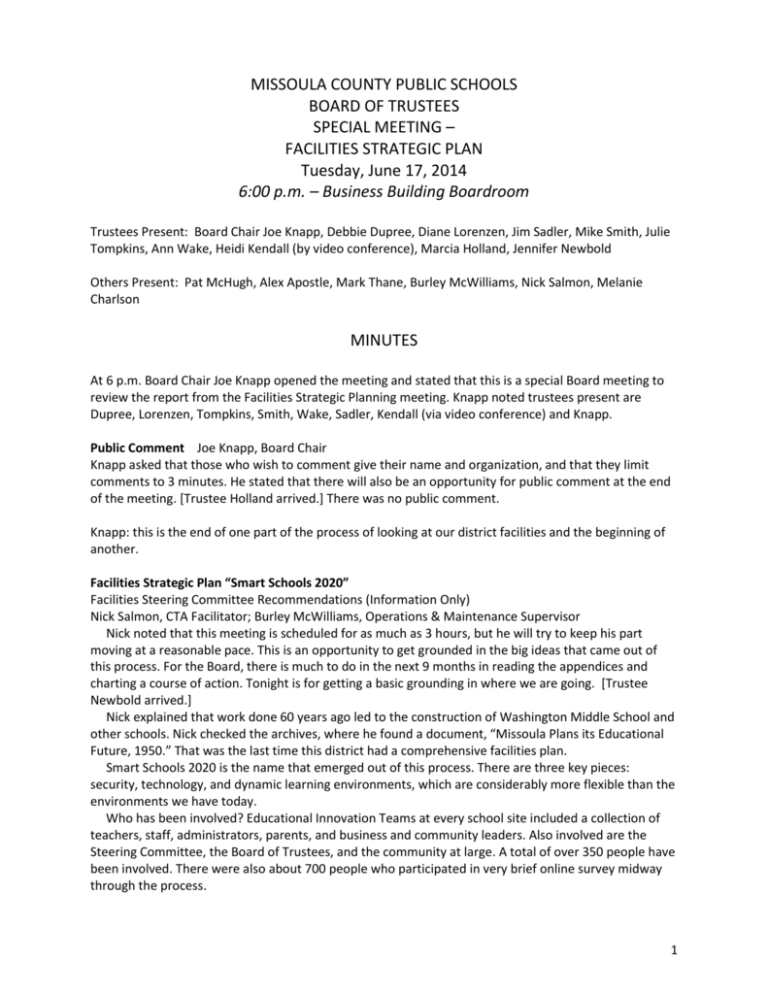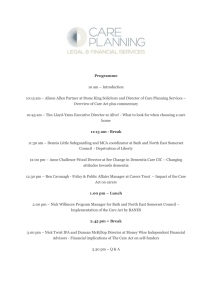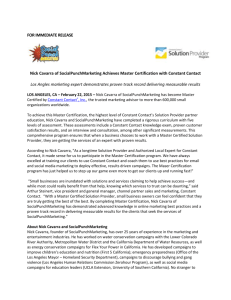Special Meeting Facility Strategic Plan Steering Committee
advertisement

MISSOULA COUNTY PUBLIC SCHOOLS BOARD OF TRUSTEES SPECIAL MEETING – FACILITIES STRATEGIC PLAN Tuesday, June 17, 2014 6:00 p.m. – Business Building Boardroom Trustees Present: Board Chair Joe Knapp, Debbie Dupree, Diane Lorenzen, Jim Sadler, Mike Smith, Julie Tompkins, Ann Wake, Heidi Kendall (by video conference), Marcia Holland, Jennifer Newbold Others Present: Pat McHugh, Alex Apostle, Mark Thane, Burley McWilliams, Nick Salmon, Melanie Charlson MINUTES At 6 p.m. Board Chair Joe Knapp opened the meeting and stated that this is a special Board meeting to review the report from the Facilities Strategic Planning meeting. Knapp noted trustees present are Dupree, Lorenzen, Tompkins, Smith, Wake, Sadler, Kendall (via video conference) and Knapp. Public Comment Joe Knapp, Board Chair Knapp asked that those who wish to comment give their name and organization, and that they limit comments to 3 minutes. He stated that there will also be an opportunity for public comment at the end of the meeting. [Trustee Holland arrived.] There was no public comment. Knapp: this is the end of one part of the process of looking at our district facilities and the beginning of another. Facilities Strategic Plan “Smart Schools 2020” Facilities Steering Committee Recommendations (Information Only) Nick Salmon, CTA Facilitator; Burley McWilliams, Operations & Maintenance Supervisor Nick noted that this meeting is scheduled for as much as 3 hours, but he will try to keep his part moving at a reasonable pace. This is an opportunity to get grounded in the big ideas that came out of this process. For the Board, there is much to do in the next 9 months in reading the appendices and charting a course of action. Tonight is for getting a basic grounding in where we are going. [Trustee Newbold arrived.] Nick explained that work done 60 years ago led to the construction of Washington Middle School and other schools. Nick checked the archives, where he found a document, “Missoula Plans its Educational Future, 1950.” That was the last time this district had a comprehensive facilities plan. Smart Schools 2020 is the name that emerged out of this process. There are three key pieces: security, technology, and dynamic learning environments, which are considerably more flexible than the environments we have today. Who has been involved? Educational Innovation Teams at every school site included a collection of teachers, staff, administrators, parents, and business and community leaders. Also involved are the Steering Committee, the Board of Trustees, and the community at large. A total of over 350 people have been involved. There were also about 700 people who participated in very brief online survey midway through the process. 1 What have we learned? Enrollment is on the rise. It has been for the last 5 years, and we are projecting another decade of rise, bringing in an additional 892 students by 2024. That is the equivalent of 2 more elementaries, or one and a half middle schools, or nearly another Big Sky HS. Enrollment is having an impact on schools today and will continue to have an impact. What have we learned? Our buildings are in need of attention. The last major comparable investment in Missoula schools resulted in the construction or expansion of Sentinel High School, Lewis and Clark, Washington, Jefferson, Roosevelt, Prescott, Hawthorne, and Franklin schools. There was approximately a $10 million dollar bond that built 414,000 square feet, 59-63 years ago. What have we learned? Without a strategic facilities plan, we have spent $50-60 million in the last 24 years meeting incremental needs. We have $65 million in deferred maintenance, accessibility, safety and energy projects. Facility condition: Age – The average age of MCPS facilities is 57 years old. 9% are greater than 100 years old; 18% are greater than 90 years old. 38% have never been expanded. You meet needs as they come up. You don’t always have the ability to step back and plan. What have we learned? We can reduce deferred maintenance and save significantly on annual energy costs. This goes back to the 2009 inventory of energy and facilities. If you were to have adopted all the energy projects identified at that time, you could save $400,000 per year from the operating budget to spend on educational programs. What have we learned? Missoula desires safe & secure schools, robust technology infrastructure, and dynamic learning spaces that are considerably more flexible than the isolated rooms we have today. That level of flexibility is not necessarily high-cost. Nick showed images of spaces that struck a chord with participants. A multipurpose space in Washington. A breakout space in Saskatchewan, where projects and presentations and technology take place in close proximity to 4-5 classrooms, giving flexibility in the way you deliver programs. They can also be the circulation spaces. Barn doors are a simple way to allow 2 adjacent groups of teachers and students to collaborate. Lorenzen: we saw some of those constructions on our school tour: L&C has something similar that they have not used as designed; they find a lot of fault with it. She would like to see us encourage L&C to use that space in the way it was designed before we create more of them. Nick replied that there were a lot of changes to educational facilities in the late 60s or 70s that were associated with best educational practices at the time, but they did not have professional development to go with it. Hawthorne has some spaces that open, but that are not used. They don’t do a good job of isolating people acoustically when they want it, and they are hard to move. This is why there is value in the demonstration projects where we are applying for the grant: it gives us a chance to implement some of the ideas at a low cost and to assess the usefulness before you invest in them in more places. Nick showed another slide with technology space that is flexible, with soft furniture. Another key item is the relevance and ability for students to apply what they are learning in the community: a slide showed students in New Orleans running a grocery store, and a garden. Will our high schools be the same size and need the same spaces we need today? In the future, we are more likely to have more flexible spaces and to work from home and work on line. Students will attend high school for all the things they can’t do individually, things they need to do as a group: music, drama, athletics, and the general social setting of the school. Nick showed a slide of a school in Kansas where students spend half the day in school and half the day working with community mentors. Steering committee recommendations: School size: 450-500 student elementary schools allow for the best implementation of full time school staff. When schools are smaller than 450, you begin to have itinerant teachers in music and P.E., rather than the onsite mentoring role. Another compelling reason for this size is that there are enough adults and students per grade level to support programs. The committee recommends 650-750 student middle schools for similar reasons. High schools can be as large as 1500-1800. Right now enrollment forecasts show all 3 high schools approaching the 1500 student range. This range gives you flexibility as 2 you go to the community and ask for something now. If enrollment continues to rise, you would have the capacity to meet it. Priorities: First, all active schools need to benefit from the investments, not a limited number of facilities. Second, we should address high and medium priority improvements between 2014 and 2024. Third, each should reduce the scope of deferred maintenance to those items related to accessibility, safety, roofs and boilers. The $65 million in deferred maintenance is too high. We need roofs to keep dry and boilers to keep warm, not the full scope of deferred maintenance. Collaboration: the Steering Committee expressed the desire that we continue to collaborate with the city and county regarding Fort Missoula, Duncan Drive, and the infrastructure adjacent to school sites. They have facilities or funding to share or recreational sites. They recommend that we collaborate with the University of Montana regarding Duncan Drive, Casaloma, and Missoula College, and with the State of Montana regarding Early Child, bonding capacity, school funding, and K-12 schools. Flexibility: the committee recommends that we improve the flexibility of learning environments in support of collaboration, learning through projects, access to technology, and community use of schools. Make sure that we are thinking of all those kinds of flexibility. High Priorities: Elementary and Middle Schools These three were the high priority items: expand and remodel Lowell and Russell replace Franklin and Cold Springs address deferred maintenance, security, and technology issues in the remaining 5 elementary school facilities and 3 middle schools Lowell: the diagram shows the recommendation to use the existing building to the greatest extent possible. Add to the north additional capacity on each of the levels of the building. Maintain the school in the same location. On the 2nd floor we show additional classroom capacity, using existing classrooms more effectively; on the top floor as well. Maintain 3 story building with the top story addition. This would refresh the building for the next 100 years. Russell: the recommendation calls for the removal of two modular buildings that are older than the school; they are 50s era modulars. Expand the building to the north. Make renovations of the existing building: address site circulation, move primary pick up and drop off area and buses along Russell. The site is 75-80% pavement now; it will be infused with more green space. Franklin: the preferred alternative is to start over on the same site rather than expand or remodel. To conserve some of the more interesting features of the facility, we would integrate them into the new building. The diagram illustrates that we can build schools 10% smaller than conventional schools but use 90% of the space rather than 65% as in conventional buildings. There is more space in terms of learning. This is a 2 story solution. Holland: how does that happen—what are you getting rid of? Nick: Corridors. Breakout areas are both corridors and breakout spaces. You get away from a significant waste of space. This is a 2 story solution on the same site; half the site is for open space. This solution is thoughtful of how the community would use the building during and after hours—e.g., pre-kindergarten is effective for the neighborhood. Cold Springs: the recommendation is to replace the school, building somewhere else in Lower Middle Creek. Lorenzen: it is important to the message that a large percentage of kids live more than 3 miles away, over 90%. The current building is in the Russell attendance area. Nick: there is a high overlap with Russell and Chief Charlo. By shifting to where students live, there is greater potential of addressing the need. Also Cold Springs was an independent grades 1-8 elementary school, which 30 years ago became part of MCPS. The most substantial addition was the west wing, all modular classrooms. The building is not necessarily a long term durable building. This is an issue the Steering Committee and the school group wrestled with. The current building was mostly a temporary solution. 3 Medium Priorities: Elementary and Middle Schools The Steering Committee recommends Light Touch expansion and remodels to all remaining schools. Chief Charlo Light Touch Improvements Lewis & Clark Expansion & Remodel Paxson Expansion & Remodel Hawthorne Expansion & Remodel Rattlesnake Expansion & Remodel Meadow Hill Expansion & Remodel CS Porter Expansion & Remodel Washington Expansion & Remodel Chief Charlo: improve technology and safety. It does not need a lot of critical upgrades. Lewis & Clark: this is an opportunity to make the building more effective. In particular, it has a partially subterranean cafeteria with no windows; it is an awkward piece of the building, with ramps to get in and out. Shift the location of the lunchroom into a more visible space with proximity to the gym and outdoors. Convert the current cafeteria into the library. The diagram has a circle on it: this is a pilot project we are submitting a grant for. Look at the south end of the building and make it a demonstration project. The 2nd story is very constricted by a long corridor. It lacks accessibility: getting an elevator to the 2nd floor is important for capacity. Paxson: it is one of our newer schools, but it lacks adequate capacity. After many iterations, the committee arrived at a simpler solution: a minor addition off to the east. The 2nd story of the addition is an opportunity for a rooftop classroom. This option will touch substantially less of the building and makes capacity equivalent to the other elementaries. Hawthorne: expansion takes care of the modular currently located to the south. It is a security concern as well as an educational concern: students and adults are not as connected to their peers in the rest of the building. The expansion gets it to capacity to meet rising enrollment. This is a 2-story solution. Rattlesnake: the basic intent is to take the temporary solution of 2 modulars and permanently integrate them into the building. This will meet the long range needs of the Rattlesnake community. The courtyard off the library—as school enrollments rise, core pieces like the library don’t always grow with them. Their idea is to grow the library into the courtyard space, maintaining the light coming in. Meadow Hill: the building has been added onto several times. Remove the honeycomb on the north end. Replace it with a grade 7 and 8 classroom stack. Modify newer parts of the building to make it easier to maneuver through. Make spaces that truly belong to each grade. The building really lacks any simple way to have visitors received and screened. By reorienting the entrance to the south side, it will be easier to implement a simple solution. Washington is struggling with its capacity. The prior solution is very expensive. Follow-up: we looked at what we can do on the main level to integrate the modulars, retain the annex but modify it to integrate, and have all shared functions take place on the main floor. There will be space for grade 6 on the main floor and space for grade 7 and 8 on the 2nd floor. This is considerably less expensive because we are doing all shared functions on the main floor. Porter: the previous preferred alternative was to relocate to the Dickinson site. At a price of $20-22 million, it was taking a substantial piece of the K-8 funds. What can be done to improve the current facility? It is still adjacent to a 6 lane highway and students come from a distance. Lorenzen: who attends Porter—we forget that it is most of Cold Springs, Hawthorne, Franklin and Lowell. Nick replied that all of Hawthorne, Franklin, and Lowell, and about half of Cold Springs attend Porter. Porter values the economic demographic diversity they have by having Cold Springs students as well as the more impoverished students. They were concerned that if they moved, that balance would be more difficult to achieve. Think how those feeder patterns work in the district. 4 High Priorities: High Schools Address deferred maintenance, security, and technology issues in all high school facilities This is an acknowledgement that we are feeling the enrollment pressure already in the elementary, and we are about to feel it in the middle schools. We have a little more time before it reaches the high schools. Nick told the Board that you may choose to take a different path. Medium priorities: High Schools Sentinel HS consolidation of music, automotive/STEM center Hellgate HS expansion and remodel Big Sky HS expansion and remodel Vo-Ag Farm processing kitchen Seeley-Swan HS music/stage Willard Alternative Program Sentinel: the basic focus is to take over Building 500, create a STEM lab at that location, and connect it to the school. Sentinel has 4 separate buildings now; it is a security challenge, and when you add the parking lots, it is even more of a challenge for safety. Link Building 500 to the main building, with a STEM center and automotive center, and core classrooms. The two south facing courtyards will be project courtyards and learning spaces, not storage. Also: shift music out of the building to the south and reattach it to where it was in the original concept, adjacent to the Margaret Johnson Theater. Also illustrated but not included in the cost: transformation of Missoula College for administration or adult education. District wide performing arts location: there is a compelling reason for this location—it is on land you already own, and there is a lot of parking you already own. Nick said that when he reexamined the cost of a new facility in the Brooks Corridor, he found that half the cost would be devoted to parking. There must be a better place for it, on land you already own. Another key: it is a very large site, 45 acres. A generation from now there might be a middle school and/or elementary on this site. It is the most flexible location for the future. Hellgate: the group scaled back their efforts substantially. We have wide hallways, with eddies in some of the hallways that could serve as great breakout areas. A lot of what we want is already there. Focus on spaces that need transformation: the 1940 east gym, which is on the 2nd floor rather than street level, is a challenge. The existing main gym could be used, and we could build an auxiliary gym on the north end of the parking lot. This allows for the creation of a real secure administration and student entry off Gerald. It creates the possibility for a common area on the main level connected to the courtyard and the street, the heart of the school. Transform the gym to take advantage of the volume, pull daylight in for art/media. They would like a STEM academy as well. It already exists: we have handson downstairs, science on the middle, and if the library were moved to the center, there would be room at the top. The idea is to take a treasured icon and build new life into it without putting tens of millions of dollars into it. Hellgate HS had a major fire that destroyed the original building. It used to have a sloping roof. There was no school in Hellgate in the middle of winter; they had to relocate students. Big Sky: the focus of that group was on a few interrelated items. Currently they have a cafetorium, where you eat and perform music and other things; the space does neither very well. Their recommendation is to expand the atrium and enclose it, creating a great space in the heart of the school for dining. That would allow the auditorium to have a stage, all within the footprint. The “ice cube tray” classrooms without windows are not a desirable model for the future: they would rethink the way that part of the building is utilized, for more effective small learning communities. A pilot project could show how one piece of the building can be transformed; we can learn from it. Seeley-Swan: Nick noted that soon he will have bicycled to every one of schools as he passes SeeleySwan when he goes to Canada. Seeley-Swan has some important needs to be met: a simple music classroom shared with a stage area built off the end of the gym. In 1964 the building was designed with that idea in mind. There are security issues in arriving at the building and from the public use of the 5 public library. It is a fairly modest request. It is all about building a really strong connection to the community in Seeley. Vo-Ag Center: also a modest request, to create a processing kitchen within their largest and newest building, to give students hands-on experience of processing and the value-added process. Willard: their preference is to leave the current facility, which is one of the grade 1-8 elementary schools that became adult ed then the alternative high school, and to build a facility that truly meets the needs of students in a more effective manner, using all the space effectively. Whether it is adjacent to the current building or somewhere else, a new effective learning environment would be much better. High Priorities: Leased, Undeveloped, Administrative Relocate Central Administration to Missoula College Dickinson Lifelong Learning Center Light Touch Improvements Issue Requests for Proposals (RFPs) for sale of Whittier, 55th and Whitaker Continue to lease Prescott These essentially came from the insights of the Steering Committee. We don’t know the precise future of Whittier, 55th and Whitaker, or Prescott, but we think Trustees should take steps toward resolving it. Tompkins asked about Early Childhood: what will it look like? Nick replied that there are 2 community stakeholder meetings we have not yet had, Early Childhood and the City of Missoula. In regards to the future of Early Childhood or pre-K programs in the region, a lot will be determined by the upcoming legislative session. The governor is going to propose introducing pre-K in all schools throughout the state, as a partnership between schools and other entities. We are illustrating the idea that pre-K may take place within the elementaries, and continuing the federally mandated preschool at Jefferson. We will know more after the conversation occurs. Tompkins asked about the Whittier property: was it discussed to use it for Early Childhood? Nick said he would have to go back and think about the range of options. He thinks it was one of them, but he added that that facility comes with a pretty large deferred maintenance price tag. Tompkins: what about what you are thinking about doing at the Willard site? Nick noted that Willard has the same footprint as Whittier. Willard is a little more accessible. It will come down to a conversation about whether it is a vision of limited centers of Early Childhood or a more dispersed model. Sadler asked about Mount Jumbo. Nick replied that we will cover it in a moment; it is not on the high priority list. Sadler asked if we would continue the lease. Nick said the recommendation is to wind down the existing lease. Mount Jumbo is a valuable swing space, especially if you are doing a major transformation of Lowell. It allows the entire school to attend there while work is being done. Smith said he remembers that price tags for different options were attached. He asked about estimates for the sales proposed. He also asked that Nick touch on the effect of getting those RFPs and selling properties as offsetting costs to taxpayers. Nick: we placed a dollar value on the cost of doing an appraisal, the legal documentation to sell a property, but not to the value of school itself. Schools are challenging buildings to sell. Hamilton was able to sell Grantsdale School for $190,000—that is more than usual. Often we are looking at very minimal dollars. Also for Roosevelt: you got $1.3 million for that. Smith: if we have RFPs we can look at offsetting the bond somewhat with sales. Nick: trustees should look at all assets that you don’t want in your portfolio and sell or swap for something you want. Lorenzen said we should think real hard about losing support for the bond by throwing property sales in with the bond. We could lose more than we gain. The value of the buildings is small. The real value is in the land. The school district is never going to be able to buy land back. To sell for $100,000 vs. the flak you would get may not be worth it. Nick: suppose the most you could get from a sale of a property is $0.5 million but you can lease it for $50,000 per year: you will derive equivalent income after 5 years vs. a onetime influx of money and political challenges. It is worth affirming with Bea precisely what you have to do associated with the sale of property. Some communities do it only through putting it on the 6 ballot, others do it through board resolutions, and others as a combination. You should confirm it with Bea. Pat: you can do either; it is the decision of the Board. If it is done by board resolution, any taxpayer can bring it into district court and dispute the sale. If it is done by ballot issue, it is not subject to dispute the same way. Nick noted that the preferred option for the Business Building is to retain it and make improvements. Dickinson: make modifications that make the gym a more flexible space, addressing other needs. Whittier: the RFP option. 55th: the RFP option. It is one where you would definitely want a detailed review of the potential of that site. It comes with zoning that allows for intense density, though not the density of adjacent areas. There are no utilities, water, or sewer. It might be that the greatest value lies in a swap for acreage somewhere else, like Lower Miller Creek. We don’t know. Sadler: or just keep it. As Diane said, it is very difficult for us to have money in the bank to buy land. He recalled being in the area of the South Hills in Moose Can Gully looking at empty space, thinking they will never build over 200 homes up here, and they did. Prescott: continue leasing as is. Medium priorities: Leased, Undeveloped, Administrative Construct new Performing Arts Facility at Sentinel Renovate Business Building as district training and technology center Issue Requests for Proposals (RFPs) for lease of Casaloma Conclude lease of Mount Jumbo in order to create swing space during construction projects Develop long term lease of Duncan Drive property Missoula County Stadium Improvements Jefferson Performing Arts: Where should the performing arts facility be? We discussed the idea of the Sentinel campus. Casaloma: the recommendation is to find a development partner who would improve the property. You retain the property and derive long term lease and income from it. This is an example of retaining property. In response to a question, Nick explained that Casaloma was a name from a restaurant. Mount Jumbo: it is a valuable single story school. You may want to unwind the lease agreement in order to have access to it in a timely manner. It has maintenance needs. In the big picture we are recommending in as many cases as possible, that you move in as is. Don’t spend a million dollars upgrading for short term use. If you had access to more funds, you probably should. Lorenzen asked about the liabilities of a lease if we cut it short. Nick replied that the lease at Mount Jumbo ends next year. Lorenzen: if we interrupted a lease we would pay it out. Nick replied that you would not be into the building until 2016 anyway. You could go month to month. Duncan Drive: the intent is let’s find a way to continue to lease the ground. To whom to lease it, the dollar value to derive, and the educational value that it represents—that is a conversation to have with the city and other partners. Like Prescott, the desire was not to do some big thing that would cause people who are inclined to support what you are doing to be opposed instead. Low Priorities: Leased, Undeveloped, Administrative Swap Linda Vista parcel adjacent to Marilyn Park for suitable school site Business as Usual for Hellgate River Bowl and Hellgate Softball/Soccer The Steering Committee recommended no major investment to be made in Hellgate River Bowl and Hellgate Softball/Soccer. If the city and county are successful in their plans, you may be able to use some of that space. The vast majority of the River Bowl is city property, an old railroad right of way. You only have 2/3 of the field and the track. Nick noted that the Hellgate soccer fields are in the Rattlesnake. 7 Nick showed a spreadsheet; it is also in the report as a pdf. Nick gave a few tools for reading it: the far left column is all facilities and sites. The first collection of columns is basic safety, deferred maintenance and technology, with a tally. The next column is options that are Business as usual, then columns for the C options, E options, etc., and then it tallies them all up. The big numbers exceed the bonding capacity in some cases, and there are notes that explain strategies to help pull costs closer to bonding capacity, e.g. by accelerating some of the projects, say in 2016 instead of 2017. Inflation of 3% per year increases the budget rapidly; doing a project a year or two earlier helps. Scope of bond It would be a single bond election with 2 bond questions (K-8 and 9-12); we would have a single election. There would be 2 bond sales each, in 2015 and 2019, to reduce the annual impact on taxpayers. For example, Billings passed a $124 million bond: they sold $70-something this year, and they will sell the rest later. You are likely to ask for one big number but ease people into it; that means taxes don’t spike. Each bond has a 20-year duration. High priority items are 2015-2019; medium priority are 2020-2023. Ten years will go by fast. Elementary Bond Elementary Deferred Maintenance Only: the bond would be $13.25 million, with a cost of $2/month, or $24/year on a $200,000 home. That is $480 over 20 years. It is only deferred maintenance, safety, and technology. No expansion, no replacement, no capacity improvements. Expansion of Lowell and Russell are not included. Replacement of Franklin and Cold Springs are not included. Capacity issues in the remaining 5 elementary schools and 3 middle schools would not be included. Elementary High Priorities Only: a $56 million bond for high priorities would cost $8/month, $100/year, a total of $1991 over 20 years. That does just the highest priority items. It includes deferred maintenance, safety, and technology; the expansion of Lowell and Russell; and the replacement of Franklin and Cold Springs. Capacity issues in the remaining 5 elementary schools and 3 middle schools would not be included. Elementary High and Medium Priorities: a $96 million bond for high and medium priorities would cost $15/month, $180/year, a total of $3600 over 20 years. It would cover all deferred maintenance, security, and technology in all buildings, as well as capacity and future flexibility in all schools. If the legislature raises your bonding capacity from $85 million to $170 million and the polling in January says there is a high level of support for $100 million, you would not need to scale back. Otherwise, you could trim $11 million by accelerating projects and reducing some of the scope. Reductions in scope are needed to fall below the current $85 million bonding capacity, which is $13/month, $156/year, a total of $3120 over 20 years. High School Bond In the high school you have $130 million bonding capacity. High School High Priories Only: a $28 million bond is $4/month, $48/year, a total of $960 over 20 years. It covers deferred maintenance, security, and technology in all buildings. Capacity and future flexibility improvements are not included, and it does not include improvements to Missoula County Stadium, which did not emerge as a high priority. It may be a priority for Trustees. We could pull together information on costs and what could be done there. High School High and Medium Priorities: a $66 million bond, at a cost of $6/month, $72/year, a total of $1440 over 20 years. It would cover deferred maintenance, security, and technology in all buildings, as well as capacity and future flexibility issues in all schools. Additional reductions are needed to fall below the current target of $50 million, which is $5/month, $60/year, a total of $1200 over 20 years. It does not include improvements to Missoula County Stadium. 8 Next steps Steering Committee Recommendations June 17, 2014. Quality Schools Project Grant is due June 26, 2014: this is an opportunity for Trustees and for members of the Steering Committee to write letters of support. Community Outreach: August-December 2014: There will be a conversation with a number of key people in the district the first week of August about technology grants. We have an opportunity to pursue a very large technology grant next spring. The time to do planning is the middle of the summer, the first week of August. Media Tours in September/October 2014: we will go to a few key targeted schools and talk about safety and security issues and technology issues as an example. E.g. if everyone turns on their smart phone at the same time in Washington MS and tries to access the web. Quality Schools Project Grant Short List: on November 1, 2014 we will find out if we are on the Governor’s list. Community Polling: January 2015. Legislative Session: January-March 2015. Friends of Smart Schools 2020: January-November 2015. Establish Smart Schools 2020 Bond Question: April 2015. Next April, Trustees will say what you think the scope of the effort should be, the dollar amount attached. Quality Schools Project Grant addressing security, technology, dynamic learning environments: Summer 2015. The intent, if you are funded for the Quality Schools Project, is to get the small scale demonstration projects done in Summer 2015. That gives students, teachers, parents, and the community the chance to see what you are talking about. Smart Schools 2020 Bond Vote: November 3, 2015. Holland: remind us what the Quality Schools Grant involves? Nick: It is a state grant. The application will be made next Thursday. There is one for the K-8 district and one for the 9-12 district, to access more funds. Funds come from the management of state lands, particularly the state trust lands, from sale of timber, oil leases, and cattle grazing, about $12 million total. Typically there are $25 million of requests. The Department of Commerce staff reviews all the applications, prioritizes and ranks them. Then they figure out where the funding line ends. The governor will change it. The legislature leapfrogged one project last session, but usually the debate is whether to fund the list or not. Knapp asked about the high and medium priorities: if the Board were to approve, give us a sense of how long the build out would take for all the projects on the list to come to fruition? Nick: you are likely to have 3-4 projects per year going on. So if you have 20-30 projects, it would take ten years. We are partly driven by advice from Dorsey & Whitney on ballot questions. In the state of Montana you can’t say please fund this project, it is a low priority and we will get to it in 15 years. In the state of Montana, you are typically restricted to asking for money and spending it in a fairly short time frame. Tompkins: who is Dorsey and Whitney? It is a firm that is bond counsel for many schools. Pat talks with them about how best to frame bonds. Tompkins: do we discuss items in terms of low priority? Or re-label them? Nick: only a very few were low priority, and those were swapping land things. Knapp told Nick that this is a lot to swallow in short time. We appreciate the opportunity to recapsule it in a short time. Public Comment Knapp asked for public questions or discussion. Please give your name and who you represent, and please keep comments to a reasonable length. Jerry Petasek spoke. He had been a student at Lowell and Porter, and he has a 4 week old at home. He wanted to talk about Whittier School, listed as a high priority for sale. He said he understands that it is not in the district, and that we need money to provide top quality education for all our students. But old neighborhood schools are not just for classes. It is an anchor for the neighborhood. It is used sunrise to sunset by community groups; it has the outdoor cinema; it is a landmark for neighborhood kids riding 9 bikes. He hopes if it gets sold that there is some way to retain those uses in the future. This is really awesome; thanks for putting it all together. Christy Dodson spoke. She went to Franklin; her father did also; her mother went to Lowell; and her grandparents graduated from Missoula County High School. She said she is a concerned citizen, and this is an opportunity for awareness. She has been working for 4 years on an electronic silent spring, about facing the dangers and creating safe limits as endorsed by the former CEO of Microsoft Canada. She read a brief commentary about biologic effects of wireless devices. This is an international discussion/raging debate. Frank Clegg, former president of Microsoft Canada and Canadians for Safe Technology sees the positive effects of technology, but contends that radiation emitted by electronics and wireless devices leads to Alzheimer’s, memory issues, and children are especially vulnerable. He recognizes electronic hypersensitivity and wants to inform the public about technology’s biological effects. Dodson invites those interested in helping to form Montanans for Safe Technology. She said this all sounds very exciting except for the wireless. Knapp thanked her for the comments. Jean Zosel of Garden City Harvest spoke. We are the current users of a big portion of the Duncan Drive property, the PEAS Farm. Nick had mentioned that one thought is how to retain the educational value we are providing at that property. She wonders why that is a medium priority, since it seems to be a pretty simple fix. Why wait 6 years to retain that educational value and make a stronger agreement? Nick commented that’s where it shook out in terms of Steering Committee priorities. Trustees, if they feel it is important to act more quickly to solidify the agreement, may do so. Knapp made a statement: this is early in the ballgame. The 11 of us sitting here have to make some pretty solid decisions in the next year, and we have to make them in a community environment. He invited the entire community to share thoughts and priorities, and to interact. This is a community wide effort and decision. He trusts we will have plenty of opportunity to engage and discuss with local groups, school communities, and cultural communities. This is an opportunity to invest in the infrastructure of our schools. He encouraged the community to think hard on this. Thanks to Nick and everyone on the Steering Committee, and to everyone who spent time to date. We need to keep this and see it through from a level appropriate to the community with regard to cost and what we plan. Knapp thanked all for being in attendance. Board Chair Joe Knapp adjourned the meeting at 7:25 p.m. As recording secretary for this Board meeting, I certify these minutes to be a true and correct copy of what was taken at the meeting. _____________________________ Elizabeth Serviss, Minutes Recorder ___________________________ Joseph Knapp, Board Chair __________________________ Pat McHugh, District Clerk 10








